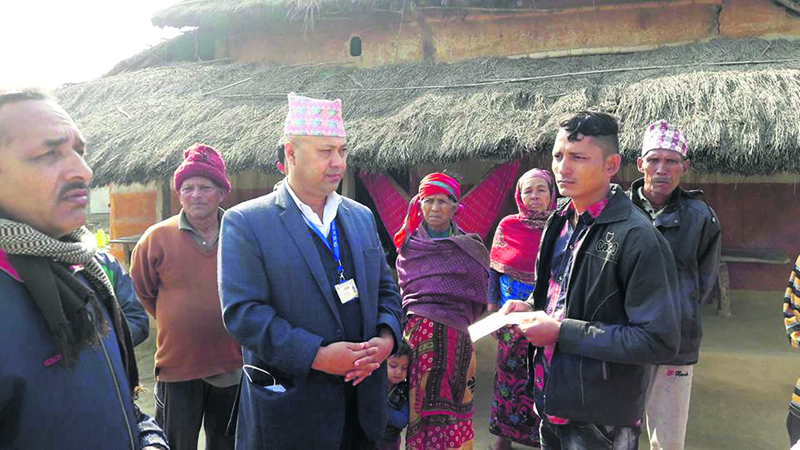
OR
Man Vs Wild: 158 humans killed in 17 years
Published On: January 26, 2017 01:00 AM NPT By: Ramesh Kumar Paudel

CHITWAN, Jan 26: Chitwan National Park (CNP) is home to thousands of wild animals and birds. Since they roam beyond the park's border they cross ways with humans. The encounters have proven fatal for both: Humans and wildlife. Residents living in adjacent buffer zones say that they love wild animals; however, they are sometimes bound to kill them to avoid being their victim. Park's record show that these human-animal encounters during the last 17 years have claimed lives of 158 humans.
In the last six months alone six people were killed by the park's inhabitants. Apart from Chitwan, wild animal attack is common in Nawalparasi, Parsa and Makwanpur, park officials informed. “The national park area is in Chitwan and Nawalparasi districts. There are settlements in buffer zones in both the districts. And human-animal encounter issue is common here and there,” said Nurendra Aryal, information officer at the CNP.
Aryal stated that one VDC each of Chitwan and Nawalparasi is used by wild animals as passage. People in these two VDCs are more at risk of being attacked by animals. “A total of eight VDCs and 11 municipalities border the park area. Of these two VDCs are commonly used by animals as passage,” he said.
Among those killed in the last 17 years, majority are from the Madi VDC. The fear still looms large among the locals. “Among 158 recorded as killed, 50 are from Madi alone. It is indeed a very sensitive matter,” said Aryal.
Narad Mani Poudel, former president of Ayodhyapuri VDC, people of Madi have been very unfortunate. “Something must be done about it by the government,” he said.
According to Poudel, locals are dependent on jungle for firewood and grass. Badarjhula, Kusumkhola and Pyauli, among other jungle areas are populated by highly aggressive wild animals like beer and tigers. “This naturally increases the chances of human - animal confrontation. And when wild beasts attack human, there are few chances of the latter winning the battle,” he said.
Apart from beer and tigers, it is the wild elephants which wreak havoc in the area. Many locals have been injured and dozens have died from elephant attacks.
“Elephants use the same route for grazing. They have amazing memory power,” said Poudel. “Unfortunately, human settlements have extended into areas which elephants have used as their pasture and travel path in the past. So, as humans have crossed into their territories, its original occupants sometimes encounter new residents of the pasture. These have increased in the numbers of encounters between elephants and humans,” he added.
The same is the view of Ram Chandra Kandel, conservation officer at the CNP. He stated that Madi area was not inhabited by humans, it was thick jungle inhabited by wild animals, including elephants in the past. “Human settled down their first making villages than slowly transforming into a thriving town. But wild animals still linger around and therefore it is always under threat of animal attack,” he said adding that “Elephants use the same route for travel and grazing for above 50 years.”
Preventive measures neglected
According to Kandel, human settlement near jungles should adopt lifestyle and practices that ensure safety of humans and the surrounding wildlife. “They should always remember that their settlement is surrounded by wilderness. So while farming as well as rearing cattle they should have arrangements to defend themselves and their livestock from wild animal attacks,” said Kandel. “Apart from this, basic knowledge over how to behave with animals is of great importance. Sometimes, humans are attacked by wild animals in retaliation.”
He said the residences in buffer zones should be designed considering the surrounding they are built. Similarly, electricity poles, water resources and fields should be built in safe areas. “If proper guidelines are followed, human-wildlife conflicts can be reduced to a great extent,” he added.
Locals, however, state that the government or the CPN have not been doing enough to reduce the losses. One of these actions, they say, would be erecting walls and fences around the national park. In response, Kandel replied that the government has been investing resources as much as possible. “We are keen to do whatever is possible for the safety of both human and animals. Initiation for building some safety mechanisms are already underway. But due to budget crunch all that could be done has not been done,” he said.
You May Like This

172 wild animals killed in three years
BANKE, Aug 4: Protection and conservation of wildlife continues to become a challenge in Banke national park with the East-West highway... Read More...

Man killed after lorry smashes car
BIRATNAGAR, Feb 17: A man was killed and another injured when a lorry with Indian registration number plate collided head... Read More...

Man gets three years for rape
SARLAHI, June 29: Sarlahi District Court has sentenced Chandra Bindnarayan Rajak, 31, to three years in jail for raping a... Read More...









Just In
- Forced Covid-19 cremations: is it too late for redemption?
- NRB to provide collateral-free loans to foreign employment seekers
- NEB to publish Grade 12 results next week
- Body handover begins; Relatives remain dissatisfied with insurance, compensation amount
- NC defers its plan to join Koshi govt
- NRB to review microfinance loan interest rate
- 134 dead in floods and landslides since onset of monsoon this year
- Mahakali Irrigation Project sees only 22 percent physical progress in 18 years









Leave A Comment